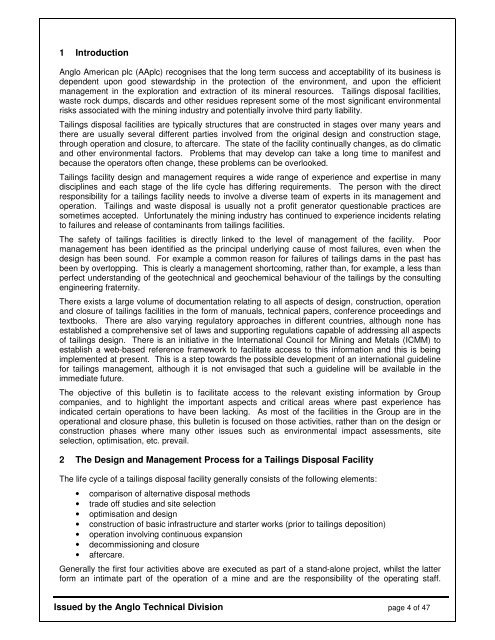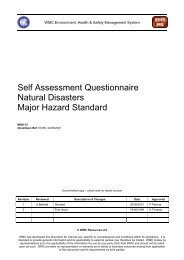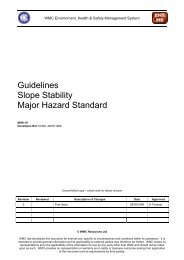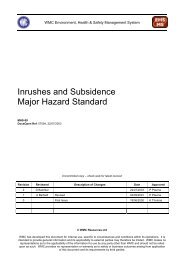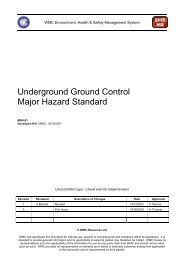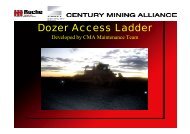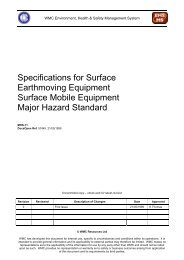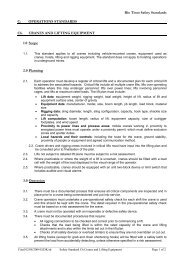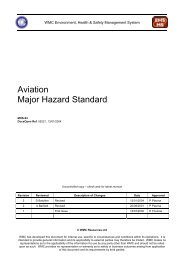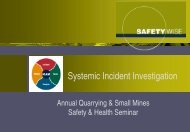SAFETY, HEALTH & ENVIRONMENT BULLETIN - MIRMgate
SAFETY, HEALTH & ENVIRONMENT BULLETIN - MIRMgate
SAFETY, HEALTH & ENVIRONMENT BULLETIN - MIRMgate
You also want an ePaper? Increase the reach of your titles
YUMPU automatically turns print PDFs into web optimized ePapers that Google loves.
1 Introduction<br />
Anglo American plc (AAplc) recognises that the long term success and acceptability of its business is<br />
dependent upon good stewardship in the protection of the environment, and upon the efficient<br />
management in the exploration and extraction of its mineral resources. Tailings disposal facilities,<br />
waste rock dumps, discards and other residues represent some of the most significant environmental<br />
risks associated with the mining industry and potentially involve third party liability.<br />
Tailings disposal facilities are typically structures that are constructed in stages over many years and<br />
there are usually several different parties involved from the original design and construction stage,<br />
through operation and closure, to aftercare. The state of the facility continually changes, as do climatic<br />
and other environmental factors. Problems that may develop can take a long time to manifest and<br />
because the operators often change, these problems can be overlooked.<br />
Tailings facility design and management requires a wide range of experience and expertise in many<br />
disciplines and each stage of the life cycle has differing requirements. The person with the direct<br />
responsibility for a tailings facility needs to involve a diverse team of experts in its management and<br />
operation. Tailings and waste disposal is usually not a profit generator questionable practices are<br />
sometimes accepted. Unfortunately the mining industry has continued to experience incidents relating<br />
to failures and release of contaminants from tailings facilities.<br />
The safety of tailings facilities is directly linked to the level of management of the facility. Poor<br />
management has been identified as the principal underlying cause of most failures, even when the<br />
design has been sound. For example a common reason for failures of tailings dams in the past has<br />
been by overtopping. This is clearly a management shortcoming, rather than, for example, a less than<br />
perfect understanding of the geotechnical and geochemical behaviour of the tailings by the consulting<br />
engineering fraternity.<br />
There exists a large volume of documentation relating to all aspects of design, construction, operation<br />
and closure of tailings facilities in the form of manuals, technical papers, conference proceedings and<br />
textbooks. There are also varying regulatory approaches in different countries, although none has<br />
established a comprehensive set of laws and supporting regulations capable of addressing all aspects<br />
of tailings design. There is an initiative in the International Council for Mining and Metals (ICMM) to<br />
establish a web-based reference framework to facilitate access to this information and this is being<br />
implemented at present. This is a step towards the possible development of an international guideline<br />
for tailings management, although it is not envisaged that such a guideline will be available in the<br />
immediate future.<br />
The objective of this bulletin is to facilitate access to the relevant existing information by Group<br />
companies, and to highlight the important aspects and critical areas where past experience has<br />
indicated certain operations to have been lacking. As most of the facilities in the Group are in the<br />
operational and closure phase, this bulletin is focused on those activities, rather than on the design or<br />
construction phases where many other issues such as environmental impact assessments, site<br />
selection, optimisation, etc. prevail.<br />
2 The Design and Management Process for a Tailings Disposal Facility<br />
The life cycle of a tailings disposal facility generally consists of the following elements:<br />
• comparison of alternative disposal methods<br />
• trade off studies and site selection<br />
• optimisation and design<br />
• construction of basic infrastructure and starter works (prior to tailings deposition)<br />
• operation involving continuous expansion<br />
• decommissioning and closure<br />
• aftercare.<br />
Generally the first four activities above are executed as part of a stand-alone project, whilst the latter<br />
form an intimate part of the operation of a mine and are the responsibility of the operating staff.<br />
Issued by the Anglo Technical Division page 4 of 47


